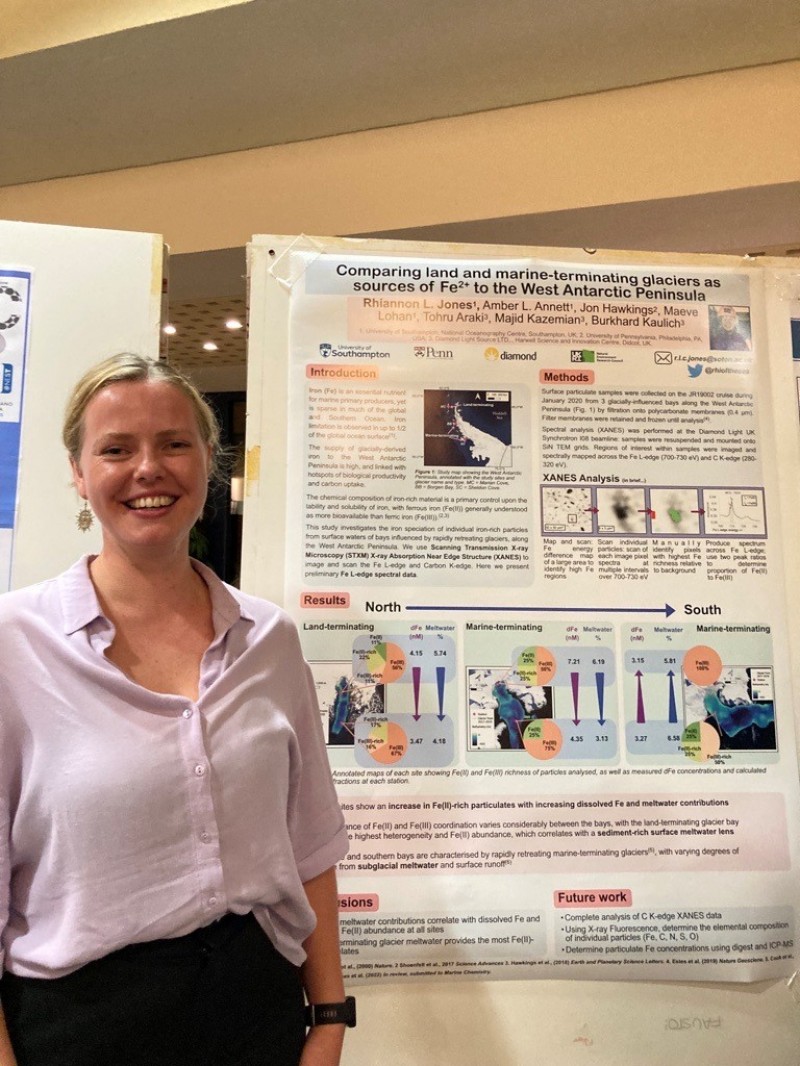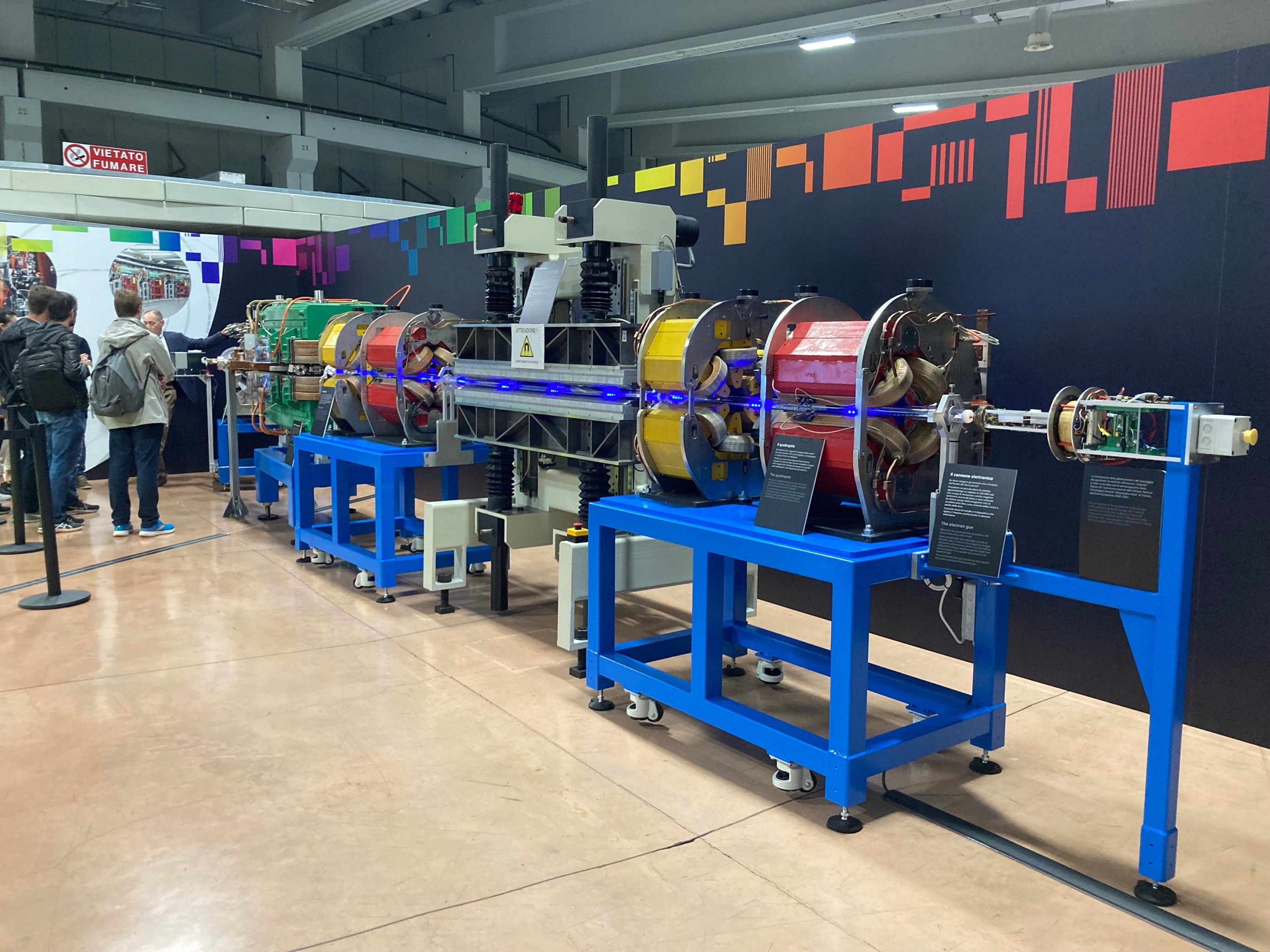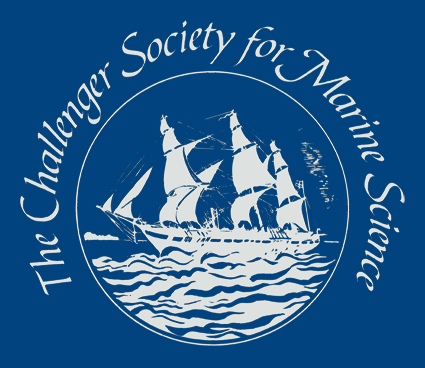SILS 16th School on Synchrotron Radiation
Rhiannon Jones
University of Southampton

During the first months of my PhD (October 2020), I was hurriedly preparing for my first fieldwork expedition to the West Antarctic Peninsula. We (myself, my supervisor, and colleagues) would be part of a large multidisciplinary project investigating the impact of rapidly retreating glaciers upon the biology, chemistry and physics of the surrounding coastal region. The West Antarctic Peninsula is one of the most rapidly warming areas of the world, and the changes this brings to nutrient cycling, such as iron, are significant yet poorly understood. In the field of trace metal biogeochemistry, the complexities associated with sample collection mean that fieldwork prep is no small feat, and I was thankful for the invaluable support of my supervisors and lab group. It was during this prep time that one supervisor suggested I consider using synchrotron radiation techniques to analyse glacial samples for the presence and speciation of iron-rich particulates. New to the field of lab-based biogeochemistry, I thought it best to plan accordingly, and learn up on these methods later (I had 2 months before the cruise!). Eighteen months on (thank you Covid-19!), a team of us were at the UK’s Diamond Light Synchrotron radiation facility, using Scanning Transmission X-ray Microscopy and X-ray Absorption Near Edge Structure analysis to locate and study the presence and valence state of iron in glacial particulates, as well as the co-location of organic carbon, which can stabilise iron in seawater. Working on the I08 Scanning X-ray Microscopy beamline was a steep learning curve, but it became clear that these techniques were incredibly powerful and valuable, and exciting conversations developed with our collaborators and the brilliant beamline techs regarding potential future work.
Caption: Model representation of the Synchrotron beam set up.
Soon after this fantastic opportunity, I discovered the Societa Italiana Luce di Sincrotrone 16th School on Synchrotron Radiation in Muggia, held from 19th-30th September 2022. Speaking with my supervisors, we agreed this would be a brilliant opportunity to develop my knowledge of synchrotron applications, network with my international peers, and inspire my plans to continue using these techniques to elucidate the composition of glacial material. The school was held in Muggia, a small fishing town outside the beautiful city of Trieste, in north-east Italy. Imagine beautiful September sun, and a sea brimming with fish. Muggia is rather small, which meant that the 60 early-career researchers who descended upon the town certainly made their mark – espresso machines worked hard to keep up with the full schedule of lectures and practicals on various frontiers in Synchrotron Radiation.
Lectures included topics such as the fundamentals of synchrotron radiation, and radiation/matter interactions, X-ray absorption and fluorescence, and photoelectron spectroscopy. Lecture highlights for me included new methods for high-resolution X-ray imaging to progress early detection of breast cancer, to the determination and mitigation of the aging process of yellow paint on Van Gogh’s famous Sunflowers using X-ray Absorption techniques.
The applications of synchrotron radiation are wide-ranging and diverse: solid-state chemistry, quantum physics, medical imaging, biocrystallography, food science, earth mantle geochemistry… the list goes on. Most of my fellow attendees were physicists, and I worked hard to try to keep up with the fundamentals of spectroscopy lectures. However, there were several people like myself, and I was excited to find a few others who studied Earth and Ocean sciences. Discussion and discovery of peers in my field was facilitated by an informal poster session (with food!). It was so wonderful to hear what other people were doing and refreshing to learn about research outside my own field. We forged professional and personal connections.
Lastly, I must mention the full day visit to the ELETTRA synchrotron and FERMI free-electron laser in Trieste, with experts hosting us at their various beamlines to show us the equipment and discuss the exciting projects ongoing. My personal highlight here was visiting the X-ray Diffraction lab, where remote users were mounting protein samples from liquid nitrogen using a robotic arm and mapping the biocrystallography into a sophisticated molecular model.
On reflection, it was important for my professional development to attend the SILS2022, meeting scientists both within and outside my field, and pushing myself to learn fundamental science and methods beyond my comfort zone. The workshop has given me the confidence in my own current and future projects too. I am deeply thankful to Challenger Society for providing me with assistance to attend SILS2022 and will forever be grateful for the opportunity and how it has shaped my personal development.
Awardee Profile: (100 words max)
I am currently a 3rd year PhD student in polar marine biogeochemistry at the University of Southampton, with a Harry Elderfield Scholarship. The PhD project aims to better understand the cycling of iron and associated elements in polar regions such as the West Antarctic Peninsula. I have an MSci in Environmental Geoscience from the University of Bristol, specialising in biogeochemical modelling. Following my MSci I did a year as a Research Associate at Bristol, continuing my Masters research. During my PhD I have carried out several marine policy placements with the University of Southampton, Defra, and the National Oceanography Centre.
Latest News
Royal Society Publishing Photography Competition 2025
Please see a message from the Royal Society below:
We are delighted to announce that the 2025 Competition is now open for entries until 15 August for a chance to win £1000! The competition celebrates the power of photography in conveying the wonder of science happening all around us and photographs can be submitted in the categories of: Astronomy, Behaviour, Earth Science and Climatology, Ecology and Environmental Science, and Microimaging.
The competition is free to enter and open to anyone studying or working in science at graduate level or above. Category winners will receive a one-year membership to the Royal Photographic Society and the overall winner will receive a grand prize of £1,000. Find out more: https://bit.ly/RSPphotocomp
October 2025 MEDIN Workshop: Marine Data Management, Governance and the MEDIN toolset
The Marine Environmental Data and Information Network (MEDIN) are pleased to announce that registration is now open for the next occurrence of our popular free online training workshop: ‘Marine Data Management, Governance and the MEDIN toolset’ on the 13th – 17th October 2025 on OceanTeacher Global Academy.
Marine Data Management, Governance and the MEDIN toolset
The Marine Environmental Data and Information Network (MEDIN) and OceanWise are delighted to invite you to attend our popular free online training workshop: ‘Marine Data Management, Governance and the MEDIN toolset’ on the 19th – 23rd of May 2025.
